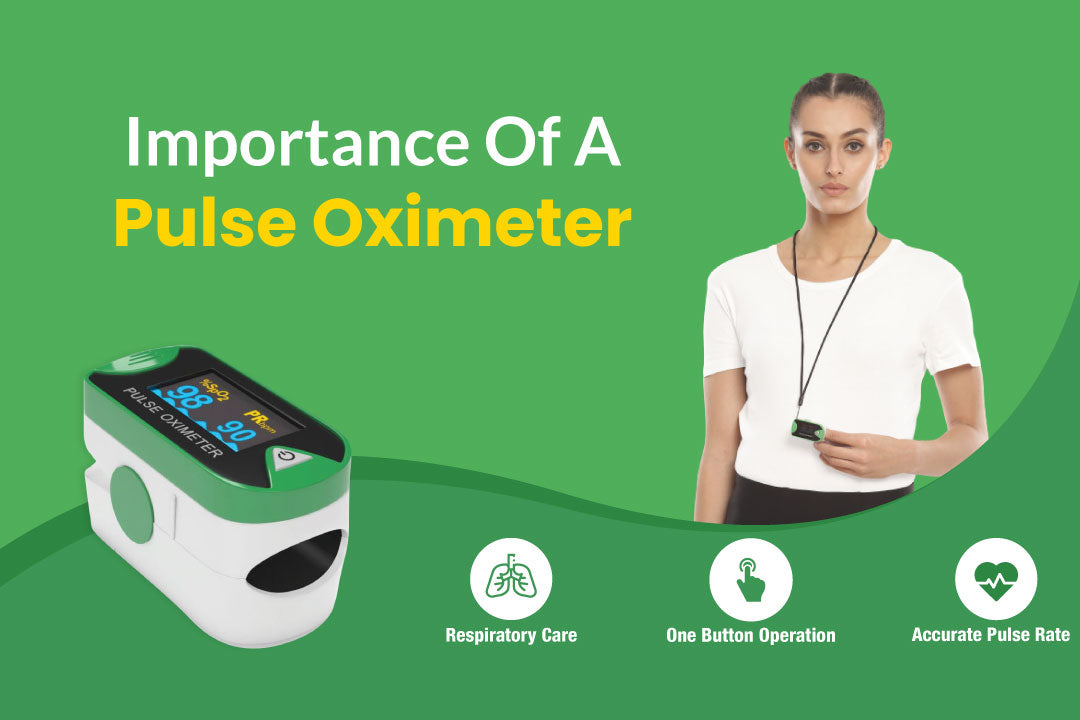Importance of Pulse Oximeter

Since the advent of COVID19, the self-health monitoring system has evolved manifold. People are more aware and keen on maintaining a healthy lifestyle. One of the common symptoms of people suffering from COVID19 was the low level of oxygen in their blood. Low oxygen levels were regarded as an early warning sign that medical care was needed.
This is when the pulse oximeter became more and more popular.
What is a Pulse Oximeter?
Pulse Oximeter is a small, lightweight tool that gained traction especially during COVID19 since it came in handy in identifying hypoxia (low oxygen saturation in the blood). The device is used to measure the amount of oxygen saturation level of blood carried in the body. It is an easy, simple & cost-saving method to spot any impending respiratory complications.
This small device can be clipped onto your finger, or any other body part such as the nose, foot, ear, or toe for measuring the pulse and oxygen level in a person’s blood.
Depleted oxygen levels in your body can be a sign of potent danger amidst the ongoing pandemic. Similar to a person’s blood pressure or body temperature, their oxygen level is also considered to be important in determining how well the person’s body is functioning. These pulse oximeters are used often in hospitals and clinics but can be bought to use at home for self-monitoring as per the doctor’s advice. Self-monitoring is especially recommended for people with lung or heart conditions.
Pulse Oximeter helps a person keep a track of their health and diagnose early on in case they require medical attention. Some people may feel well and may have low oxygen levels whereas some may feel very sick but have good oxygen levels. People or their caretakers who monitor oxygen levels at home should keep this in mind when looking at results.
How Does a Pulse Oximeter Help
The sole purpose of a pulse oximeter is to see if the blood in your body is well oxygenated.
Other than this, a pulse oximeter can be used for the following:
- Evaluate how well the lung medication is working.
- Monitor oxygen level during or after surgical procedures
- Evaluate if the ventilator is helpful
- to determine the effectiveness of supplemental oxygen therapy, especially in case of a new treatment.
- Evaluate a person's ability to tolerate increased physical activity after treatment or surgery
- Evaluate the oxygen level of a person during his daily activities.
- Assess the breathing pattern of a person during a sleep study or in cases like sleep apnea
To detect oxygen saturation levels in the blood accurately it must be used correctly. Mentioned below are a few instructions:
- Clip the small device on the fingertips in a way that is neither too loose nor too tight.
- Select the finger that fits into the device. This is necessary for an accurate reading. Clipping the device on a larger finger can damage it whereas using it on the smaller finger may not provide an accurate reading.
- It is advisable to get rid of nail polishes, henna/mehndi, and long artificial nails in advance. Make sure to clean your fingers before taking the reading. All this can interfere with accurate oximeter readings.
- You may also get an inaccurate reading in case of poor circulation or dark skin pigmentation.
- Sunlight or any source of bright light may interfere with the light detector and may cause inaccuracy.
- The pulse oximeter digital can also display an inaccurate reading if the person’s temperature is cold.
If you are using a pulse oximeter at home for self-monitoring, then we recommend following the below-mentioned steps for an accurate reading.
- Before you begin, make sure to remove any jewelry or fingernail polish if you are using your finger to take the measurement.
- You can clip the device on your finger, earlobe, or toe.
- In case you are clipping the device to your finger, make sure to relax and keep your hand warm and below heart level.
- Keep the device on for as long as needed to evaluate your pulse and oxygen saturation level.
- Once the test is done remove the device gently.
Once finished you can expect a quick and easy measurement of oxygen saturation level displayed on the monitor. People using pulse oximeters at home are advised to reach out to their healthcare providers in case of a low oxygen saturation level immediately.
There are no known risks or dangers associated with using pulse oximeters. Along with an accurate reading, a good at-home use pulse oximeter should be user-friendly. Hence, choosing a suitable device from the plethora of devices available in the market becomes necessary.
Romsons Oxee Check Finger Pulse Oximeter is a Doctor Trusted pulse oximeter readily available for your use. Romsons Oxee Check Finger Pulse Oximeter is a super convenient and user-friendly device. The packaging comes with an oximeter, a pair of batteries, and a strap to hang the machine around the neck. Its simple and compact design consumes low power and runs for up to 30 hours continuously on two AAA batteries. The device shuts off automatically after 8 seconds when no signal is detected.
Word of caution: People using pulse oximeters at home are advised to reach out to their healthcare providers immediately in case of a low oxygen saturation level.


